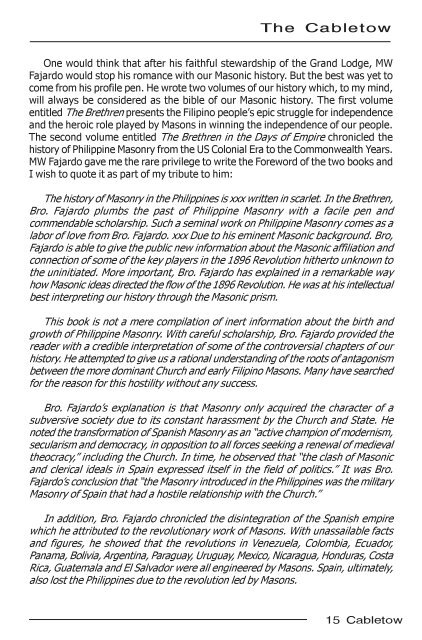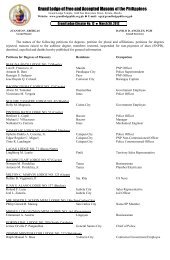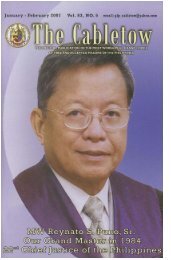Cabletow 4th issue - GM Ebdane - Grand Lodge of the Philippines
Cabletow 4th issue - GM Ebdane - Grand Lodge of the Philippines
Cabletow 4th issue - GM Ebdane - Grand Lodge of the Philippines
You also want an ePaper? Increase the reach of your titles
YUMPU automatically turns print PDFs into web optimized ePapers that Google loves.
The <strong>Cabletow</strong><br />
One would think that after his faithful stewardship <strong>of</strong> <strong>the</strong> <strong>Grand</strong> <strong>Lodge</strong>, MW<br />
Fajardo would stop his romance with our Masonic history. But <strong>the</strong> best was yet to<br />
come from his pr<strong>of</strong>ile pen. He wrote two volumes <strong>of</strong> our history which, to my mind,<br />
will always be considered as <strong>the</strong> bible <strong>of</strong> our Masonic history. The first volume<br />
entitled The Brethren presents <strong>the</strong> Filipino people’s epic struggle for independence<br />
and <strong>the</strong> heroic role played by Masons in winning <strong>the</strong> independence <strong>of</strong> our people.<br />
The second volume entitled The Brethren in <strong>the</strong> Days <strong>of</strong> Empire chronicled <strong>the</strong><br />
history <strong>of</strong> Philippine Masonry from <strong>the</strong> US Colonial Era to <strong>the</strong> Commonwealth Years.<br />
MW Fajardo gave me <strong>the</strong> rare privilege to write <strong>the</strong> Foreword <strong>of</strong> <strong>the</strong> two books and<br />
I wish to quote it as part <strong>of</strong> my tribute to him:<br />
The history <strong>of</strong> Masonry in <strong>the</strong> <strong>Philippines</strong> is xxx written in scarlet. In <strong>the</strong> Brethren,<br />
Bro. Fajardo plumbs <strong>the</strong> past <strong>of</strong> Philippine Masonry with a facile pen and<br />
commendable scholarship. Such a seminal work on Philippine Masonry comes as a<br />
labor <strong>of</strong> love from Bro. Fajardo. xxx Due to his eminent Masonic background. Bro,<br />
Fajardo is able to give <strong>the</strong> public new information about <strong>the</strong> Masonic affiliation and<br />
connection <strong>of</strong> some <strong>of</strong> <strong>the</strong> key players in <strong>the</strong> 1896 Revolution hi<strong>the</strong>rto unknown to<br />
<strong>the</strong> uninitiated. More important, Bro. Fajardo has explained in a remarkable way<br />
how Masonic ideas directed <strong>the</strong> flow <strong>of</strong> <strong>the</strong> 1896 Revolution. He was at his intellectual<br />
best interpreting our history through <strong>the</strong> Masonic prism.<br />
This book is not a mere compilation <strong>of</strong> inert information about <strong>the</strong> birth and<br />
growth <strong>of</strong> Philippine Masonry. With careful scholarship, Bro. Fajardo provided <strong>the</strong><br />
reader with a credible interpretation <strong>of</strong> some <strong>of</strong> <strong>the</strong> controversial chapters <strong>of</strong> our<br />
history. He attempted to give us a rational understanding <strong>of</strong> <strong>the</strong> roots <strong>of</strong> antagonism<br />
between <strong>the</strong> more dominant Church and early Filipino Masons. Many have searched<br />
for <strong>the</strong> reason for this hostility without any success.<br />
Bro. Fajardo’s explanation is that Masonry only acquired <strong>the</strong> character <strong>of</strong> a<br />
subversive society due to its constant harassment by <strong>the</strong> Church and State. He<br />
noted <strong>the</strong> transformation <strong>of</strong> Spanish Masonry as an “active champion <strong>of</strong> modernism,<br />
secularism and democracy, in opposition to all forces seeking a renewal <strong>of</strong> medieval<br />
<strong>the</strong>ocracy,” including <strong>the</strong> Church. In time, he observed that “<strong>the</strong> clash <strong>of</strong> Masonic<br />
and clerical ideals in Spain expressed itself in <strong>the</strong> field <strong>of</strong> politics.” It was Bro.<br />
Fajardo’s conclusion that “<strong>the</strong> Masonry introduced in <strong>the</strong> <strong>Philippines</strong> was <strong>the</strong> military<br />
Masonry <strong>of</strong> Spain that had a hostile relationship with <strong>the</strong> Church.”<br />
In addition, Bro. Fajardo chronicled <strong>the</strong> disintegration <strong>of</strong> <strong>the</strong> Spanish empire<br />
which he attributed to <strong>the</strong> revolutionary work <strong>of</strong> Masons. With unassailable facts<br />
and figures, he showed that <strong>the</strong> revolutions in Venezuela, Colombia, Ecuador,<br />
Panama, Bolivia, Argentina, Paraguay, Uruguay, Mexico, Nicaragua, Honduras, Costa<br />
Rica, Guatemala and El Salvador were all engineered by Masons. Spain, ultimately,<br />
also lost <strong>the</strong> <strong>Philippines</strong> due to <strong>the</strong> revolution led by Masons.<br />
15 <strong>Cabletow</strong>








